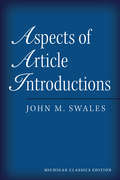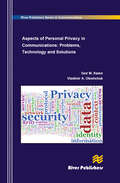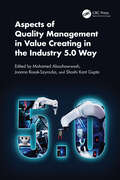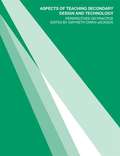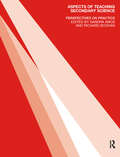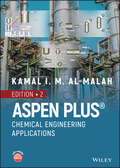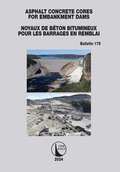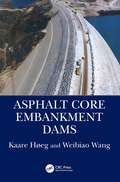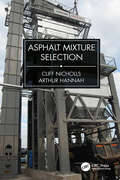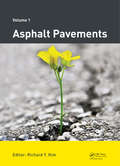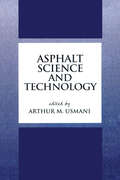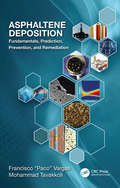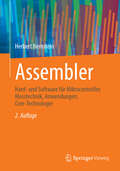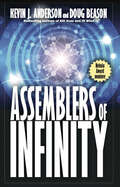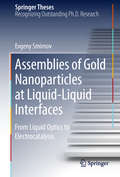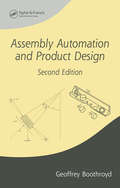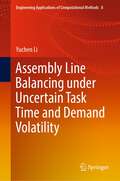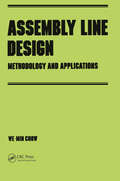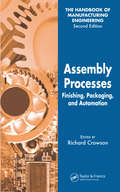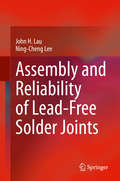- Table View
- List View
Aspects of Article Introductions
by Swales John M.Aspects of Article Introductions has bee reissued to make it more easily available than it has ever been, particularly for the use of university libraries and for younger and newer practitioners and researchers in the rapidly expanding and increasingly global field of EAP. The originalAspects of Article Introductionsappeared in fall 1981 as a ring-bound 90-page monograph. The “publisher” was the Language Studies Unit at the University of Aston in Birmingham. Although essentially an “underground” work, it has remained a relevant part of the short intellectual history of English for Academic Purposes, particularly as genre-based or genre-driven approaches to EAP research and pedagogical practice have become more popular. Its longevity is also a testament to the genre analysis work of John Swales, but in addition, the research article has become the most influential genre in most areas of scholarship, and introductions are at leastsupposedto be read first and to be designed in such a way as to attract as large readership as possible. “If I were asked to list the most influential texts in applied linguistics over the last 30 years, John Swales'Aspects of Article Introductionswould be in the top three or four. This was a seminal work which not only presented a novel way of analysing texts and a commentary on academic discourse, but one which helped to establish a foundation for the massive interest we see today in describing the structure and features of academic articles. This is not just a text which offers us a glimpse of an intellectual history, but it remains full of fascinating insights and observations about texts and the workings of academic discourse. While the ideas may have evolved and the genre it describes moved on, both the style of writing and the methodology it describes are as fresh and as revealing as anything written on the topic since. ” ---Ken Hyland, Hong Kong University
Aspects of Kolmogorov Complexity the Physics of Information (River Publishers Series In Information Science And Technology Ser.)
by Bradley S. TiceThe research presented in Aspects of Kolmogorov Complexity addresses the fundamental standard of defining randomness as measured by a Martin-Lof level of randomness as found in random sequential binary strings. A classical study of statistics that addresses both a fundamental standard of statistics as well as an applied measure for statistical communication theory. The research points to compression levels in a random state that are greater than is found in current literature. A historical overview of the field of Kolmogorov Complexity and Algorithmic Information Theory, a subfield of Information Theory, is given as well as examples using a radix 3, radix 4, and radix 5 base numbers for both random and non-random sequential strings. The text also examines monochromatic and chromatic symbols and both theoretical and applied aspects of data compression as they relate to the transmission and storage of information. The appendix contains papers on the subject given at conferences and the references are current.ContentsTechnical topics addressed in Aspects of Kolmogorov Complexity include:• Statistical Communication Theory• Algorithmic Information Theory• Kolmogorov Complexity• Martin-Lof Randomness• Compression, Transmission and Storage of Information
Aspects of Personal Privacy in Communications - Problems, Technology and Solutions
by Geir M. Koien Vladimir a. OleshchukThe modern society is rapidly becoming a fully digital society. This has many benefits, but unfortunately it also means that personal privacy is threatened. The threat does not so much come from a 1984 style Big Brother, but rather from a set of smaller big brothers. The small big brothers are companies that we interact with; they are public services and institutions. Many of these little big brothers are indeed also being invited to our private data by ourselves. Privacy as a subject can be problematic. At the extreme it is personal freedom against safety and security. We shall not take a political stand on personal privacy and what level of personal freedom and privacy is the correct one.Aspects of Personal Privacy in Communications is mostly about understanding what privacy is and some of the technologies may help us to regain a bit of privacy. We discuss what privacy is about, what the different aspects of privacy may be and why privacy needs to be there by default.There are boundaries between personal privacy and societal requirements, and inevitably society will set limits to our privacy (Lawful Interception, etc.).There are technologies that are specifically designed to help us regain some digital privacy. These are commonly known as Privacy Enhancing Technologies (PETs). We investigate some these PETs including MIX networks, Onion Routing and various privacy-preserving methods. Other aspects include identity and location privacy in cellular systems, privacy in RFID, Internet-of-Things (IoT) and sensor networks amongst others. Some aspects of cloud systems are also covered.
Aspects of Quality Management in Value Creating in the Industry 5.0 Way
by Mohamed Abouhawwash Joanna Rosak-Szyrocka Shashi Kant GuptaIndustry 5.0 suggests a new stage of industrial growth that expands upon earlier stages of industrialization, emphasizing human-centered approaches to technology and digital sustainability. With its innovative approach, Industry 5.0 will contribute to the resolution of the manufacturing–social need mismatch issue. In contrast to other industrial revolutions that placed more emphasis on the financial aspects of sustainability, the Industry 5.0 vision places more emphasis on social demands and human centricity.This book Aspects of Quality Management in Value Creating in the Industry 5.0 Way focuses on the challenges that companies in the field of quality management in Industry 5.0 face, particularly in relation to client value aspects. The book devotes a lot of space to the issues of client satisfaction, cybersecurity, e-commerce, TQM, and collaborative work between robots and humans in the company.Features: Characterizes the new role of value for customer 5.0 in the augmented era Analyzes the collaborative work between robots and humans in Industry 5.0 conditions Investigates the complex relationship between satisfaction, awareness, perception, attitude, and demographics, as well as examining how technological advances and market performance impact client satisfaction Includes: E-client in the cyber-security aspect Multi-Agent Technology (MAT) to maintain Total Quality Management (TQM) in manufacturing and MAT’s role in TQM A novel structure for innovation, "Innovation Control (IC)," to integrate creative thinking and business strategy Industry 5.0 inside the automotive sector Technetronic Education (TE) in Industry 5.0: advantages, challenges, and implications Ethical aspects and challenges associated with developing technologies This book Aspects of Quality Management in Value Creating in the Industry 5.0 Way serves as a future road map, guiding readers through the complexities of industrial progress.Academic researchers, along with senior undergraduate and graduate students, are the primary target audience.
Aspects of Teaching Secondary Design and Technology: Perspectives on Practice
by Gwyneth Owen-JacksonBeginning by outlining the national curriculum for design and technology, Aspects of Teaching Secondary Design and Technology goes on to look at what design and technology is in the primary school, at examination level and post-16. Vocational qualifications relevant to design and technology are also discussed. There are chapters looking at the relationship between design and technology and the wider social and cultural context. The development of cross-curricular skills and value judgements are discussed as are sustainability and the role of the community in the teaching and learning of design and technology. Together, these articles comprise a sound guide to good classroom practice, related to the requirements of the curriculum, and rooted in the professional perspectives of experienced teachers.
Aspects of Teaching Secondary Science: Perspectives on Practice
by Sandra Amos Richard BoohanThis book's structure reflects the different dimensions to learning science. The first section focuses on the importance of talk in the science classroom, while the second explores the key role of practical work. The third section is concerned with the creative, theoretical aspect of science. Section four follows this by considering the communication of ideas and how pupils learn to participate in the discourse of the scientific community. Section five emphasizes the place of science in the broader context, considering its moral and ethical dimensions and its place in a cultural context. Finally, section six explores the complexity of the task faced by science teachers, highlighting the knowledge and skills science teachers must acquire in order to create an environment in which students are motivated to learn science.
Aspen Plus: Chemical Engineering Applications
by Kamal I. Al-MalahASPEN PLUS® Comprehensive resource covering Aspen Plus V12.1 and demonstrating how to implement the program in versatile chemical process industries Aspen Plus®: Chemical Engineering Applications facilitates the process of learning and later mastering Aspen Plus®, the market-leading chemical process modeling software, with step-by-step examples and succinct explanations. The text enables readers to identify solutions to various process engineering problems via screenshots of the Aspen Plus® platforms in parallel with the related text. To aid in information retention, the text includes end-of-chapter problems and term project problems, online exam and quiz problems for instructors that are parametrized (i.e., adjustable) so that each student will have a standalone version, and extra online material for students, such as Aspen Plus®-related files, that are used in the working tutorials throughout the entire textbook. The second edition of Aspen Plus®: Chemical Engineering Applications includes information on: Various new features that were embedded into Aspen Plus V12.1 and existing features which have been modified Aspen Custom Modeler (ACM), covering basic features to show how to merge customized models into Aspen Plus simulator New updates to process dynamics and control and process economic analysis since the first edition was published Vital areas of interest in relation to the software, such as polymerization, drug solubility, solids handling, safety measures, and energy saving For chemical engineering students and industry professionals, the second edition of Aspen Plus®: Chemical Engineering Applications is a key resource for understanding Aspen Plus and the new features that were added in version 12.1 of the software. Many supplementary learning resources help aid the reader with information retention.
Aspen Plus: Chemical Engineering Applications
by Kamal I.M. Al-MalahFacilitates the process of learning and later mastering Aspen Plus® with step by step examples and succinct explanations Step-by-step textbook for identifying solutions to various process engineering problems via screenshots of the Aspen Plus® platforms in parallel with the related text Includes end-of-chapter problems and term project problems Includes online exam and quiz problems for instructors that are parametrized (i.e., adjustable) so that each student will have a standalone version Includes extra online material for students such as Aspen Plus®-related files that are used in the working tutorials throughout the entire textbook
Asphalt Concrete Cores for Embankment Dams / Noyaux de Béton Bitumineux Pour Les Barrages en Remblai (ICOLD Bulletins Series)
by International Commission on Large Dams Commission Internationale Des Grands BarragesThis Bulletin covers the state-of-the-art of current practice after the important development in design and construction during the last 25 years. It addresses all aspects of the design, construction, performance and operation. Characteristics of asphalt concrete cores, requirements for the mix design, laboratory testing and quality control are discussed. Technical specifications are also presented and proposed. Finally, several typical case histories with characteristics and performance are given in Appendices.Ce Bulletin présente l’état actuel des dernières pratiques suite aux développements importants en conception et en construction accomplis au cours des 25 dernières années. Il renferme tous les aspects de la conception, de la construction, du comportement et de l’exploitation. Les caractéristiques des noyaux de béton bitumineux, les exigences pour la conception des mélanges, les essais en laboratoire et le contrôle de la qualité sont analysés. Le devis descriptif est également présenté et proposé. Pour terminer, plusieurs cas-types, accompagnés des caractéristiques et du comportement, sont relatés en annexe.
Asphalt Core Embankment Dams
by Kaare Høeg Weibiao WangDams are built for several purposes, e.g., water supply, irrigation, hydropower production, or flood control. The main categories are concrete dams and embankment dams, but inside each of these two main general categories, there are several different types. Asphalt Core Embankment Dams focusses on the design and construction of these types of dams. Asphalt core embankment dams are gaining in popularity, as their recorded field performance is excellent, they are economically very competitive, and the construction period may be shortened compared to other types of embankment dams. This book presents several case studies of dams that have been successfully built and been in service for many years, and: introduces the concept of using asphalt concrete core rather than earth core or upstream facing; points out there is no concern about internal erosion when using hydraulic asphalt concrete in the core; discusses material selection and mix design for hydraulic asphalt concrete to achieve flexibility and ductility; discusses suitability testing and asphalt concrete mix improvements and optimization by using additives; presents the use of triaxial tests, tension tests, and bending tests to study cracking resistance and potential self-healing; discusses the use of modern construction equipment and field quality control; shows that asphalt core dams may reduce the construction period compared to other options; and treats earthquake resistance of this type of dams. The authors have built on decades of experience with the design and construction, construction control, and research and development for asphalt core embankment dams. Asphalt Core Embankment Dams is aimed at engineering students, practising engineers, civil engineering contractors, equipment suppliers, and asphalt producers.
Asphalt Mixture Selection
by Cliff Nicholls Arthur HannahThis practical guide starts with a survey of the types of site and the asphalt properties which are required. Various external influences which may affect the relative importance of some properties are addressed, and the interplay of sites and external is considered. Asphalt mixture types and their properties are reviewed, largely as defined in the EN 13108 series but subdivided into further categories, and into maximum nominal coarse aggregate sizes using EN 13043 basic set plus set 2 sizes. Guidance is given, including using flowcharts, of the different mixtures that are suitable for each situation. In some cases a range of choices or mixtures with different degrees of suitability is offered. The guidance covers surface course, binder course and base, but with more focus on the surface course where the external influence is most significant. The site and external influence combinations on which a mixture can be used successfully are also given. The book is primarily intended for those who select asphalt on an occasional basis, such as architects or housing developers, but could be of use to other engineers with limited experience. It is also useful as an educational textbook for those studying asphalt technology.
Asphalt Mixture Specification and Testing
by Cliff NichollsThis guide reviews the way asphalt mixture can be specified, with particular emphasis on the test methods used to measure performance. The advantages and limitations of the tests are described for measuring the desired property, and engineers can specify a test according to the material’s use. The book starts with a resume of specifications and their relative advantages and disadvantages for different situations. Then different properties are discussed in terms of: their specification; the test methods that can be used (primarily the EN 12697 suite of European methods, of which the author has been responsible for drafting); the extent to which the results predict performance; the levels that can be achieved with different asphalt mixes and types; what levels, if any, should be specified in various situations and pavement layers; and which other properties are adversely affected by enhanced performance. The final section covers various aspects of sustainability, with a strong emphasis on durability. Better understanding should enable clients and consultants who specify pavements to produce durable asphalt pavements more economically, and also help asphalt producers and students trying to understand the black art of asphalt.
Asphalt Pavements
by Y. Richard KimAsphalt Pavements contains the proceedings of the International Conference on Asphalt Pavements (Raleigh, North Carolina, USA, 1-5 June 2014), and discusses recent advances in theory and practice in asphalt materials and pavements. The contributions cover a wide range of topics:- Environmental protection and socio-economic impacts- Additives and mo
Asphalt Pavements: A Practical Guide to Design, Production and Maintenance for Engineers and Architects
by Patrick LavinAsphalt Pavements provides the know-how behind the design, production and maintenance of asphalt pavements and parking lots. Incorporating the latest technology, this book is the first to focus primarily on the design, production and maintenance of low-volume roads and parking areas.Special attention is given to determining the traffic capacity, re
Asphalt Science and Technology
by Arthur Usmani"Offers comprehensive, authoritative coverage of the chemistry, technology, and engineering of asphaltic products for paving, road construction, roofing, coatings, adhesives, and batteries. Analyzes microcracking and elucidates the mechanisms of degradation to aid the development of hot melt asphalt and increase longevity."
Asphaltene Deposition: Fundamentals, Prediction, Prevention, and Remediation
by Francisco M. Vargas and Mohammad TavakkoliAs global consumption of fossil fuels such as oil increases, previously abundant sources have become depleted or plagued with obstructions. Asphaltene deposition is one of such obstructions which can significantly decrease the rate of oil production. This book offers concise yet thorough coverage of the complex problem of asphaltene precipitation and deposition in oil production. It covers fundamentals of chemistry, stabilization theories and mechanistic approaches of asphaltene behavior at high temperature and pressure. Asphaltene Deposition: Fundamentals, Prediction, Prevention, and Remediation explains techniques for experimental determination of asphaltene precipitation and deposition and different modeling tools available to forecast the occurrence and magnitude of asphaltene deposition in a given oil field. It discusses strategies for mitigation of asphaltene deposition using chemical inhibition and corresponding challenges, best practices for asphaltene remediation, current research, and case studies.
Assembler: Hard- und Software für Mikrocontroller, Messtechnik, Anwendungen, Core-Technologie
by Herbert BernsteinIn diesem Fachbuch für Assemblerprogrammierung werden die erforderlichen Kenntnisse auf dem Gebiet der Hardware und Software in einander greifend erklärt. Es wird in zahlreichen Applikationen das Zusammenspiel der einzelnen Steuerbits und -worte anhand praktischer Anwendungen dargestellt.
Assembler: Hard- und Software für Mikrocontroller, Messtechnik, Anwendungen, Core-Technologie
by Herbert BernsteinIn diesem Fachbuch für Assemblerprogrammierung werden die erforderlichen Kenntnisse auf dem Gebiet der Hardware und Software in einander greifend erklärt. Es wird in zahlreichen Applikationen das Zusammenspiel der einzelnen Steuerbits und -worte anhand praktischer Anwendungen dargestellt.
Assemblers of Infinity
by Kevin J. Anderson Doug BeasonEarth&’s thriving lunar colony faces a mysterious, growing threat on the far side of the Moon . . . an alien invasion or nanotechnology run amuck. The crew of Moonbase Columbus makes an amazing discovery on the far side of the Moon—a massive alien structure is erecting itself, built up atom by atom by living machines, microscopically small, intelligent, and unstoppable, consuming everything they touch. The mysterious structure begins to expand and take shape, and its creators begin to multiply. Is this the first strike in an alien invasion from the stars? Is it an attempt at first contact? Or has human nanotechnology experimentation gone awry, triggering an unexpected infestation? As riots rage across a panicked Earth, scientists scramble to learn the truth before humanity&’s home is engulfed by the voracious machines. Praise for Assemblers of Infinity Nebula Award Nominee &“The authors have a fine grasp of character and a slick writing style.&” —Science Fiction Review&“Anderson and Beason are the heavyweight tag-team of hard science fiction!&” —Allen Steele, author of Labyrinth of Night&“Wonderfully vivid, Terrifying, and worse yet . . . realistic!&” —David Brin, author of Startide Rising
Assemblies of Gold Nanoparticles at Liquid-Liquid Interfaces: From Liquid Optics to Electrocatalysis (Springer Theses)
by Evgeny SmirnovNominated as an outstanding Ph.D. thesis by the École Polytechnique Fédérale de Lausanne, Switzerland.<P><P> Shows the self-assembly of gold nanoparticles into nanoparticles films Investigates the optical, mechanical and electrochemical properties of metal liquid-like droplets.<P> Explores the elctrocatalytic capability of nanoparticles placed at the interface.<P> This book is devoted to various aspects of self-assembly of gold nanoparticles at liquid-liquid interfaces and investigation of their properties. It covers primarily two large fields: (i) self-assembly of nanoparticles and optical properties of these assemblies; and (ii) the role of nanoparticles in redox electrocatalysis at liquid-liquid interfaces. The first part aroused from a long-lasting idea to manipulate adsorption of nanoparticles at liquid-liquid with an external electric field to form 'smart' mirrors and/or filters. Therefore, Chapters 3 to 5 are dedicated to explore fundamental aspects of charged nanoparticles self-assembly and to investigate optical properties (extinction and reflectance) in a through manner. Novel tetrathiafulvalene (TTF)-assisted method leads to self-assembly of nanoparticles into cm-scale nanofilms or, so-called, metal liquid-like droplets (MeLLDs) with remarkable optical properties. The second part (Chapters 6 to 8) clarifies the role of nanoparticles in interfacial electron transfer reactions. They demonstrate how nanoparticles are charged and discharged upon equilibration of Fermi levels with redox couples in solution and how it can be used to perform HER and ORR. Finally, Chapter 9 gives a perspective outlook, including applications of suggested methods in fast, one-step preparation of colloidosomes, SERS substrates as well as pioneer studies on so-called Marangony-type shutters drive by the electric field.
Assembly Automation and Product Design (ISSN)
by Geoffrey BoothroydThe design for assembly (DFA) method has become a widely used way for companies to introduce competitive designs at reduced costs. This text places the consideration and application of automatic assembly in the context of DFA, addressing product design for both automated and manual assembly processes. The author enumerates the components, processes, performance, and comparative economics of several types of automatic assembly systems. To this end, the book includes specific information on equipment such as transfer devices, parts feeders, feed tracks, placing mechanisms, and robots. This is an ideal reference and guide for manufacturing, product design, mechanical, and industrial engineers.
Assembly Line Balancing under Uncertain Task Time and Demand Volatility (Engineering Applications of Computational Methods #8)
by Yuchen LiThis book introduces several mathematical models in assembly line balancing based on stochastic programming and develops exact and heuristic methods to solve them. An assembly line system is a manufacturing process in which parts are added in sequence from workstation to workstation until the final assembly is produced. In an assembly line balancing problem, tasks belonging to different product models are allocated to workstations according to their processing times and precedence relationships among tasks. It incorporates two features, uncertain task times, and demand volatility, separately and simultaneously, into the conventional assembly line balancing model. A real-life case study related to the mask production during the COVID-19 pandemic is presented to illustrate the application of the proposed framework and methodology. The book is intended for graduate students who are interested in combinatorial optimizations in manufacturing with uncertain input.
Assembly Line Design: Methodology and Applications
by We-Min ChowThis book attempts to treat line design and its related subjects in a cohesive manner, with an emphasis on design applications. It discusses general guidelines for setting up assumptions and determining line performance parameters, based on empirical data from literature reports.
Assembly Processes: Finishing, Packaging, and Automation (Handbook of Manufacturing Engineering, Second Edition)
by Richard CrowsonToday's fast-paced manufacturing culture demands a handbook that provides how-to, no-holds-barred, no-frills information. Completely revised and updated, the Handbook of Manufacturing Engineering is now presented in four volumes. Keeping the same general format as the first edition, this second edition not only provides more information but makes i
Assembly and Reliability of Lead-Free Solder Joints
by John H. Lau Ning-Cheng LeeThis book focuses on the assembly and reliability of lead-free solder joints. Both the principles and engineering practice are addressed, with more weight placed on the latter. This is achieved by providing in-depth studies on a number of major topics such as solder joints in conventional and advanced packaging components, commonly used lead-free materials, soldering processes, advanced specialty flux designs, characterization of lead-free solder joints, reliability testing and data analyses, design for reliability, and failure analyses for lead-free solder joints. Uniquely, the content not only addresses electronic manufacturing services (EMS) on the second-level interconnects, but also packaging assembly on the first-level interconnects and the semiconductor back-end on the 3D IC integration interconnects. Thus, the book offers an indispensable resource for the complete food chain of electronics products.
